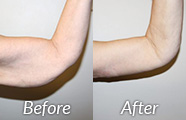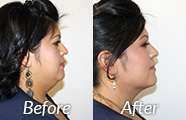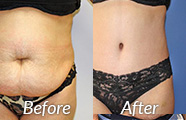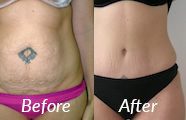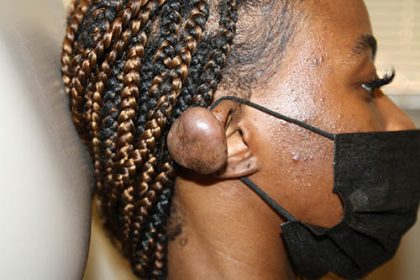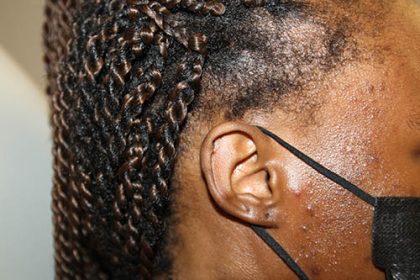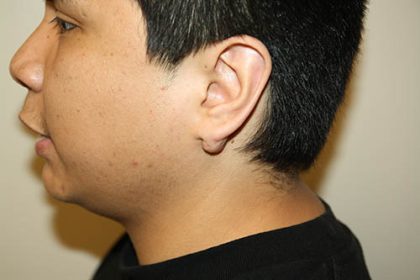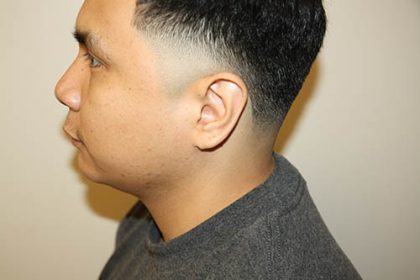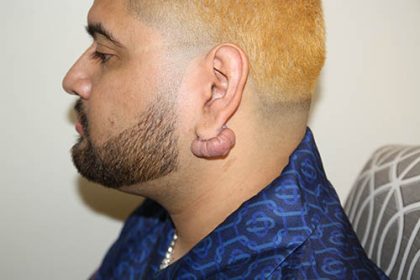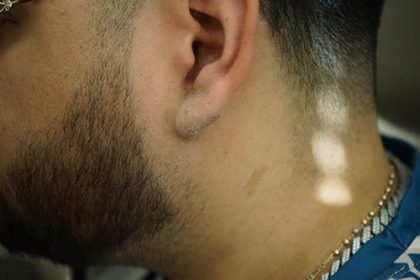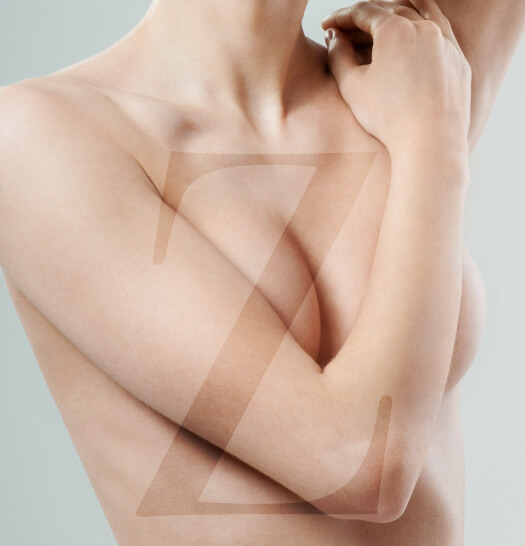Keloid Surgery
Conveniently located to serve the areas of Santa Monica, Beverly Hills and Greater Los Angeles
A keloid is unlike other scars, in more ways than one. Keloids form when excess collagen grows in response to an injury. However, unlike normal scars, they continue to enlarge over time and extend beyond the place the original injury occurred. (1) These areas of abnormal tissue can be rubbery in appearance and can range from pink to dark brown in color. They can be large and unsightly, and can cause a significant amount of distress in people of any age. Unfortunately, these scars frequently recur and rarely improve without suitable treatment to mitigate their appearance and effects.
Dr. Michael Zarrabi is a board-certified plastic and reconstructive surgeon who offers tailored surgical procedures for men and women dealing with debilitating keloid scars. He and his team provide optimized care and effective treatment for keloid scars, as well as providing other surgical and non-surgical services to address aesthetic issues in the face, breasts, and body. To schedule a consultation at his Santa Monica or Beverly Hills office, please call (310) 584-9990 or fill out the contact form on our website.
Contents
Before and After Photos
About Keloids
Keloids form when something goes wrong with the wound healing process. These growths are often large, rubbery, type of hypertrophic scar, or one that is raised from the skin’s surface. Fibroblasts, types of cells that form connective tissue, go into overdrive to produce collagen and growth factors to heal a wound or fight inflammation. However, these cells produce more than the desired amount of collagen in some people. Collagen is a protein that serves as part of the scaffolding of our skin. When a keloid forms, it’s due to bundles of keloidal collagen and fibroblast cells forming in the area.
There are many problems people with keloid scars face, both physical and mental. If the scar itself is large, or if it is in a particularly conspicuous place, it may cause self-consciousness and distress. Keloid development can also cause:
- Burning
- Pain
- Itchy Skin (Pruritus)
- Limited Movement
- Skin Sensitivity (hyperesthesia) (2)
One keloid study found that 86% of participants complained of pruritus, while almost half (46%) experienced pain. Further research shows that keloids not only cause discomfort, but that they can also cause psychological distress and social difficulties. (3) So finding physical and mental relief through surgery can be vital.
Keloids can grow past the threshold of disfigurement without expert medical intervention. If you have a keloid scar that is causing discomfort, it may impact your quality of life and lead to insecurity in your appearance. Therefore, it’s essential to find a treatment that works for you, and opt for surgery if the growth is affecting you physically, psychologically, or socially.
Who is High Risk for Keloids?
Keloids can occur at any age in both men and women. Although no specific gene has been identified, research indicates that the formation of keloids has a genetic component. There are certain populations that are more susceptible to developing them. These include darker-skinned individuals of African, Asian, and Hispanic descent. They are also far more common in people under the age of 30.
Scar Contracture
Scar contracture can occur when tissue heals abnormally. It’s common in burn injuries, and can result in severe disfigurement. The skin loses elasticity and becomes rigid and tightly stretched. Some hypertrophic scarring and keloids are an example of this. Typically, hypertrophic scars get smaller over time, particularly if they are treated with steroid injections. However, a keloid scar is different. It can change shape, and may exceed the size of the original wound itself.
Combating Keloids
For people prone to keloid formation, the best way to keep them at bay is to reduce the risk of them occurring to begin with. Keloids only develop in certain patients following a wound or tissue inflammation. Since the skin is prone to abnormal healing, it’s best to avoid procedures such as ear piercing, body piercing, tattooing, and elective cosmetic surgeries. When they do appear following tissue trauma, keloids often require a multi-pronged approach. Treatment options include:
- Surgical Excision
- Corticosteroids
- Cryotherapy
- Pressure Therapy
- Silicone Gel Sheeting
- Radiotherapy
- Laser Therapy
It should be stressed that keloid recurrence in many patients is high. However, with the right approach, keloid recurrence can be managed. Dr. Zarrabi will discuss your keloid surgery during your personal consultation. If you’re ready to book one with us, please fill out our online form.
What Can Keloid Surgery Do?
Surgery is a doctor-recommended first-line treatment for keloids, if disabling scar contracture is present. (4) Surgical excision of keloids can be combined with other mitigation techniques like steroid injections for the most effective results. Keloid surgery provides relief for people with keloids, and allows them to be free from the self-consciousness of the condition. This can lead to increased confidence, increased choice in clothing, and the ability to live your life to the fullest with peace of mind.
Candidates
Candidates for keloid surgery are people who experience abnormal wound healing. They may or may not have had a large keloid before, the lesion may have become noticeably bigger or it may be causing pain or discomfort. There may also be more than one lesion to treat. Keloid surgery may also be useful for people when prior treatments have failed to produce desirable results.
Personal Consultation
Dr. Michael Zarrabi’s years of experience as a plastic and reconstructive surgeon can help you deal with the effects of keloid scarring. Your personal consultation is an opportunity for you to express your concerns and explain how your scars are negatively impacting your daily life. Please inform him if your scars are causing you pain.
Once you’ve given us some basic information about your health, we will ask a few questions regarding your history of surgery, injury, and if other people in your family have keloid scars. Dr. Zarrabi will then perform a physical examination of the keloid(s), noting their size, shape, and the extent of scar contracture present. He will devise a treatment plan based on your individual needs.
Getting Keloid Surgery
Keloids can appear in many different areas of the body, including the ears, cheeks, shoulders, and chest. Severe hypertrophic scars can appear anywhere in susceptible patients where a skin injury has occurred. Because of the individual nature of the location, size, and impact of keloids, treatment plans and surgical techniques and the duration of the surgery may vary from patient to patient.
In most cases, procedures are performed under local anesthesia. The surgical removal of keloids typically takes 30 minutes to an hour depending on the extent of surgery required. Keloids have a fibrous core, which must be removed to reduce the size of the lesion. After removing the unwanted keloid and scar tissue, the normal skin edges are once again brought together.
The wound is then often injected with cortisone to prevent the keloid from reforming. Dressings are removed in 48 hours and sutures after one week. Silicone gel sheeting, taping, compression, and repeat cortisone (steroid) injections can be incorporated into the aftercare, in order to minimize the chance of recurrence.
Dr. Zarrabi performs keloid surgery at his exclusive Santa Monica plastic surgery office and invites you to learn more about this popular procedure. Keloid surgery can dramatically improve your appearance by removing disfiguring scars on the ears, face or anywhere on the body.
For examples of Dr. Zarrabi’s keloid surgery results, please see our real patient photo gallery. You can also read more about the procedures Dr. Zarrabi performs by reading his reviews.
Cost of Keloid Surgery in Beverly Hills, CA
The cost of your surgery will depend on the extent of your treatment and the other ways Dr. Zarrabi mitigates the reoccurrence of the scar. You may qualify for financing. Please book a personal consultation for further information about keloid surgery at your earliest convenience, find relief from disfiguring keloid scars, and discover better quality of life. Contact us at (310) 584-9990 to book your appointment at our Beverly Hills or Santa Monica office.
See Dr. Zarrabi’s appearances in the media here, and join us on our socials for more information about the surgical and non-surgical procedures he offers.
FAQ
Why do my scars cause pain?
Many types of scar cause pain long after the initial tissue damage. In normal scars, hypertrophic scars and keloids, scar tissue can develop over time as the body repairs the wound. However, over time, the nerve activity in the area can also return. Nerve endings regenerate in many types of scar, causing pain and discomfort.
Why is my keloid scar larger than the original injury?
One of the features of keloids is the overgrowth of collagen fibers that form raised lesions that can develop beyond the initial border of the scar.
What’s the best way to remove keloid scars?
There is no “one size fits all” for keloid treatment. If you are prone to keloids, they are likely to return once removed. Usually, doctors advise a combined approach with the incorporation of surgical removal, steroid injections, and silicone sheets to diminish the appearance of scarring. In some cases, cryotherapy (extremely cold temperatures), pressure therapy, radiotherapy, and laser therapy may be used.
References
- McGinty S, Siddiqui WJ. Keloid. PubMed. Published 2020. https://www.ncbi.nlm.nih.gov/books/NBK507899/
- Ojeh N, Bharatha A, Gaur U, Forde AL. Keloids: Current and emerging therapies. Scars, Burns & Healing. 2020;6:205951312094049. https://www.ncbi.nlm.nih.gov/pmc/articles/PMC7418256/
- Lu W, Chu H, Zheng X. Effects on quality of life and psychosocial wellbeing in Chinese patients with keloids. American journal of translational research. 2021;13(3):1636-1642. Accessed July 28, 2022. https://www.ncbi.nlm.nih.gov/pmc/articles/PMC8014351/#:~:text=In%20addition%20to%20pain%20and
Kim SW. Management of keloid scars: noninvasive and invasive treatments. Archives of Plastic Surgery. 2021;48(2):149-157. https://www.ncbi.nlm.nih.gov/pmc/articles/PMC8007468/


